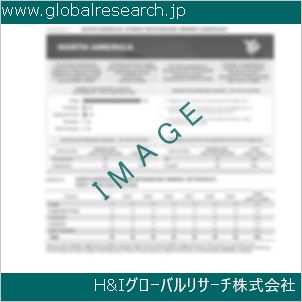目次
第1章 グローバル空間センサーおよびアクチュエーター市場レポートの範囲と方法論
1.1. 研究目的
1.2. 研究方法論
1.2.1. 予測モデル
1.2.2. デスク調査
1.2.3. トップダウンとボトムアップアプローチ
1.3. 研究属性
1.4. 研究の範囲
1.4.1. 市場定義
1.4.2. 市場セグメンテーション
1.5. 研究の仮定
1.5.1. 包含と除外
1.5.2. 制限事項
1.5.3. 調査対象期間
第2章 執行要約
2.1. CEO/CXOの視点
2.2. 戦略的洞察
2.3. ESG分析
2.4. 主要な発見
第3章 グローバル宇宙センサーおよびアクチュエーター市場動向分析
3.1. グローバルな宇宙センサーおよびアクチュエーター市場を形作る市場動向(2024–2035)
3.2. 推進要因
3.2.1. グローバルな宇宙探査プログラムの強化
3.2.2. 商業用衛星コンステレーションの拡大
3.3. 制約
3.3.1. 高い開発・認証コスト
3.3.2. 過酷な放射線および熱環境
3.4. 機会
3.4.1. 小型衛星プラットフォームの普及
3.4.2. 民間宇宙企業の台頭と軌道上サービス
第4章 グローバル宇宙センサーおよびアクチュエーター産業分析
4.1. ポーターの5つの力モデル
4.1.1. 購入者の交渉力
4.1.2. 供給者の交渉力
4.1.3. 新規参入の脅威
4.1.4. 代替品の脅威
4.1.5. 競合企業の競争
4.2. ポーターの5つの力予測モデル(2024–2035)
4.3. PESTEL分析
4.3.1. 政治
4.3.2. 経済的
4.3.3. 社会
4.3.4. 技術的
4.3.5. 環境
4.3.6. 法的
4.4. 主要な投資機会
4.5. 主要な成功戦略(2025年)
4.6. 市場シェア分析(2024–2025)
4.7. グローバル価格分析と動向(2025年)
4.8. 分析家の推奨事項と結論
第5章. グローバルな宇宙センサーおよびアクチュエーター市場規模と予測(製品タイプ別)2025–2035
5.1. 市場概要
5.2. センサー
5.2.1. 主要国別内訳推計と予測(2024–2035年)
5.2.2. 地域別市場規模分析、2025–2035
5.3. アクチュエーター
5.3.1. 主要国別市場規模推計と予測(2024年~2035年)
5.3.2. 地域別市場規模分析、2025–2035
第6章. グローバルな宇宙センサーおよびアクチュエーター市場規模と予測(プラットフォーム別)、2025–2035
6.1. 市場概要
6.2. 衛星
6.2.1. 主要国別市場規模推計と予測(2024~2035年)
6.2.2. 地域別市場規模分析(2025年~2035年)
6.3. カプセル/貨物
6.3.1. 主要国別内訳推計と予測(2024~2035年)
6.3.2. 市場規模分析(地域別)、2025–2035
6.4. 惑星間宇宙船および探査機
6.4.1. 主要国別内訳推計と予測(2024年~2035年)
6.4.2. 地域別市場規模分析、2025–2035
6.5. ローバー/宇宙船着陸機
6.5.1. 主要国別市場規模推計と予測(2024年~2035年)
6.5.2. 地域別市場規模分析、2025–2035
6.6. 打ち上げロケット
6.6.1. 主要国別内訳推計と予測(2024年~2035年)
6.6.2. 地域別市場規模分析、2025–2035
第7章. グローバル宇宙センサーおよびアクチュエーター市場規模と予測(地域別)、2025–2035
7.1. 市場、地域別概要
7.2. 主要国と新興国
7.3. 北米市場
7.3.1. 米国市場
7.3.1.1. 製品タイプ別市場規模と予測(2025–2035年)
7.3.1.2. プラットフォーム別市場規模と予測(2025~2035年)
7.3.2. カナダ市場
7.3.2.1. 製品タイプ別市場規模と予測(2025年~2035年)
7.3.2.2. プラットフォーム別市場規模と予測(2025年~2035年)
7.4. 欧州市場
7.4.1. イギリス市場
7.4.1.1. 製品タイプ別市場規模と予測(2025年~2035年)
7.4.1.2. プラットフォーム別市場規模と予測(2025年~2035年)
7.4.2. ドイツ市場
7.4.2.1. 製品タイプ別市場規模と予測(2025年~2035年)
7.4.2.2. プラットフォーム別市場規模と予測(2025年~2035年)
7.4.3. フランス市場
7.4.3.1. 製品タイプ別市場規模と予測(2025年~2035年)
7.4.3.2. プラットフォーム別市場規模と予測(2025年~2035年)
7.4.4. スペイン市場
7.4.4.1. 製品タイプ別市場規模と予測(2025年~2035年)
7.4.4.2. プラットフォーム別市場規模と予測(2025年~2035年)
7.4.5. イタリア市場
7.4.5.1. 製品タイプ別市場規模と予測(2025年~2035年)
7.4.5.2. プラットフォーム別市場規模と予測(2025年~2035年)
7.4.6. 欧州その他の地域市場
7.4.6.1. 製品タイプ別市場規模と予測(2025年~2035年)
7.4.6.2. プラットフォーム別市場規模と予測(2025年~2035年)
7.5. アジア太平洋市場
7.5.1. 中国市場
7.5.1.1. 製品タイプ別市場規模と予測(2025~2035年)
7.5.1.2. プラットフォーム別市場規模と予測(2025年~2035年)
7.5.2. インド市場
7.5.2.1. 製品タイプ別市場規模と予測(2025~2035年)
7.5.2.2. プラットフォーム別市場規模と予測(2025年~2035年)
7.5.3. 日本市場
7.5.3.1. 製品タイプ別市場規模と予測(2025年~2035年)
7.5.3.2. プラットフォーム別市場規模と予測(2025年~2035年)
7.5.4. オーストラリア市場
7.5.4.1. 製品タイプ別市場規模と予測(2025~2035年)
7.5.4.2. プラットフォーム別市場規模と予測(2025年~2035年)
7.5.5. 韓国市場
7.5.5.1. 製品タイプ別市場規模と予測(2025~2035年)
7.5.5.2. プラットフォーム別市場規模と予測(2025年~2035年)
7.5.6. アジア太平洋地域(APAC)の残りの市場
7.5.6.1. 製品タイプ別市場規模と予測(2025年~2035年)
7.5.6.2. プラットフォーム別市場規模と予測(2025年~2035年)
7.6. ラテンアメリカ市場
7.6.1. ブラジル市場
7.6.1.1. 製品タイプ別市場規模と予測(2025~2035年)
7.6.1.2. プラットフォーム別市場規模と予測(2025年~2035年)
7.6.2. メキシコ市場
7.6.2.1. 製品タイプ別市場規模と予測(2025年~2035年)
7.6.2.2. プラットフォーム別市場規模と予測(2025年~2035年)
7.7. 中東・アフリカ市場
7.7.1. アラブ首長国連邦(UAE)市場
7.7.1.1. 製品タイプ別市場規模と予測(2025年~2035年)
7.7.1.2. プラットフォーム別市場規模と予測(2025年~2035年)
7.7.2. サウジアラビア市場
7.7.2.1. 製品タイプ別市場規模と予測(2025~2035年)
7.7.2.2. プラットフォーム別市場規模と予測(2025年~2035年)
7.7.3. 南アフリカ市場
7.7.3.1. 製品タイプ別市場規模と予測(2025年~2035年)
7.7.3.2. プラットフォーム別市場規模と予測(2025年~2035年)
第8章 競合分析
8.1. 主要市場戦略
8.2. ハネウェル・インターナショナル・インク
8.2.1. 会社概要
8.2.2. 主要幹部
8.2.3. 会社の概要
8.2.4. 財務実績(データ入手状況により異なります)
8.2.5. 製品/サービスポートフォリオ
8.2.6. 最近の動向
8.2.7. 市場戦略
8.2.8. SWOT分析
8.3. Moog Inc.
8.4. テレス・グループ
8.5. ノースロップ・グラマン社
8.6. コリンズ・エアロスペース(レイセオン・テクノロジーズ)
8.7. BAE システムズ PLC
8.8. サフラン S.A.
8.9. STマイクロエレクトロニクス
8.10. テレダイン・テクノロジーズ
8.11. テキサス・インスツルメンツ
8.12. シエラ・ネバダ・コーポレーション
8.13. ボール・エアロスペース・アンド・テクノロジーズ・コーポレーション
8.14. カーティス・ライト・コーポレーション
8.15. コンスバーグ・グループ・ASA
8.16. L3ハリス・テクノロジーズ株式会社
8.12. シエラネバダ・コーポレーション
表の一覧
表1. グローバル宇宙センサーおよびアクチュエーター市場、レポートの範囲
表2. グローバル宇宙センサーおよびアクチュエーター市場推定値および予測(地域別)2024–2035
表3. グローバル宇宙センサーおよびアクチュエーター市場規模推計および予測(製品タイプ別)2024–2035
表4. グローバル宇宙センサーおよびアクチュエーター市場規模推計および予測(プラットフォーム別)2024–2035
表5. グローバル宇宙センサーおよびアクチュエーター市場規模予測(2024年~2035年)
表6. グローバル宇宙センサーおよびアクチュエーター市場規模予測(エンドユーザー別)2024–2035
表7. 米国宇宙センサーおよびアクチュエーター市場規模予測(2024–2035年)
表8. カナダ 宇宙センサーおよびアクチュエーター市場規模予測(2024–2035年)
表9. イギリス 宇宙センサーおよびアクチュエーター市場規模予測(2024–2035年)
表10. ドイツの宇宙用センサーおよびアクチュエーター市場規模推計と予測(2024–2035年)
表11. フランス 宇宙用センサーおよびアクチュエーター市場規模推計と予測(2024–2035年)
表12. スペインの宇宙センサーおよびアクチュエーター市場規模推計と予測(2024–2035年)
表13. イタリア 宇宙用センサーおよびアクチュエーター市場規模推計と予測(2024–2035年)
表14. 欧州その他の地域 宇宙用センサーおよびアクチュエーター市場規模推計と予測(2024–2035年)
表15. 中国の宇宙用センサーおよびアクチュエーター市場規模推計と予測(2024~2035年)
表16. インドの宇宙用センサーおよびアクチュエーター市場規模推計と予測(2024~2035年)
表17. 日本の宇宙用センサーおよびアクチュエーター市場規模推計と予測(2024年~2035年)
表18. オーストラリアの宇宙センサーおよびアクチュエーター市場規模推計と予測(2024–2035年)
表19. 韓国の宇宙用センサーおよびアクチュエーター市場規模推計と予測(2024–2035年)
表20. ブラジル 宇宙用センサーおよびアクチュエーター市場規模推計と予測(2024–2035年)
図表一覧
図1. グローバル宇宙センサーおよびアクチュエーター市場、調査方法論
図2. グローバル宇宙センサーおよびアクチュエーター市場、市場推定手法
図3. グローバル市場規模推計および予測方法
図4. グローバル宇宙センサーおよびアクチュエーター市場、2025年の主要動向
図5. グローバル宇宙センサーおよびアクチュエーター市場、成長見通し(2024年~2035年)
図6. グローバル宇宙センサーおよびアクチュエーター市場、ポーターの5つの力モデル
図7. グローバル宇宙センサーおよびアクチュエーター市場、PESTEL分析
図8. グローバル宇宙センサーおよびアクチュエーター市場、バリューチェーン分析
図9. 宇宙センサーおよびアクチュエーター市場(製品タイプ別)、2025年および2035年
図10. 宇宙センサーおよびアクチュエーター市場(プラットフォーム別)、2025年と2035年
図11. 宇宙センサーおよびアクチュエーター市場(用途別)、2025年および2035年
図12. 宇宙センサーおよびアクチュエーター市場(エンドユーザー別)、2025年および2035年
図13. 北米の宇宙用センサーおよびアクチュエーター市場、2025年と2035年
図14. 欧州の宇宙センサーおよびアクチュエーター市場、2025年と2035年
図15. アジア太平洋地域 宇宙用センサーおよびアクチュエーター市場、2025年および2035年
図16. ラテンアメリカ 宇宙用センサーおよびアクチュエーター市場、2025年および2035年
図17. 中東・アフリカ 宇宙センサーおよびアクチュエーター市場、2025年および2035年
図18. グローバル宇宙センサーおよびアクチュエーター市場、企業別市場シェア分析(2025年)
Chapter 1. Global Space Sensors and Actuators Market Report Scope & Methodology
1.1. Research Objective
1.2. Research Methodology
1.2.1. Forecast Model
1.2.2. Desk Research
1.2.3. Top-Down and Bottom-Up Approach
1.3. Research Attributes
1.4. Scope of the Study
1.4.1. Market Definition
1.4.2. Market Segmentation
1.5. Research Assumption
1.5.1. Inclusion & Exclusion
1.5.2. Limitations
1.5.3. Years Considered for the Study
Chapter 2. Executive Summary
2.1. CEO/CXO Standpoint
2.2. Strategic Insights
2.3. ESG Analysis
2.4. Key Findings
Chapter 3. Global Space Sensors and Actuators Market Forces Analysis
3.1. Market Forces Shaping the Global Space Sensors and Actuators Market (2024–2035)
3.2. Drivers
3.2.1. Intensification of Global Space Exploration Programs
3.2.2. Expansion of Commercial Satellite Constellations
3.3. Restraints
3.3.1. High Development and Qualification Costs
3.3.2. Harsh Radiation and Thermal Environments
3.4. Opportunities
3.4.1. Proliferation of Small Satellite Platforms
3.4.2. Rise of Private Space Ventures and In-Orbit Servicing
Chapter 4. Global Space Sensors and Actuators Industry Analysis
4.1. Porter’s Five Forces Model
4.1.1. Bargaining Power of Buyers
4.1.2. Bargaining Power of Suppliers
4.1.3. Threat of New Entrants
4.1.4. Threat of Substitutes
4.1.5. Competitive Rivalry
4.2. Porter’s Five Forces Forecast Model (2024–2035)
4.3. PESTEL Analysis
4.3.1. Political
4.3.2. Economic
4.3.3. Social
4.3.4. Technological
4.3.5. Environmental
4.3.6. Legal
4.4. Top Investment Opportunities
4.5. Top Winning Strategies (2025)
4.6. Market Share Analysis (2024–2025)
4.7. Global Pricing Analysis and Trends 2025
4.8. Analyst Recommendation & Conclusion
Chapter 5. Global Space Sensors and Actuators Market Size & Forecasts by Product Type 2025–2035
5.1. Market Overview
5.2. Sensors
5.2.1. Top Countries Breakdown Estimates & Forecasts, 2024–2035
5.2.2. Market Size Analysis, by Region, 2025–2035
5.3. Actuators
5.3.1. Top Countries Breakdown Estimates & Forecasts, 2024–2035
5.3.2. Market Size Analysis, by Region, 2025–2035
Chapter 6. Global Space Sensors and Actuators Market Size & Forecasts by Platform 2025–2035
6.1. Market Overview
6.2. Satellites
6.2.1. Top Countries Breakdown Estimates & Forecasts, 2024–2035
6.2.2. Market Size Analysis, by Region, 2025–2035
6.3. Capsules/Cargos
6.3.1. Top Countries Breakdown Estimates & Forecasts, 2024–2035
6.3.2. Market Size Analysis, by Region, 2025–2035
6.4. Interplanetary Spacecraft & Probes
6.4.1. Top Countries Breakdown Estimates & Forecasts, 2024–2035
6.4.2. Market Size Analysis, by Region, 2025–2035
6.5. Rovers/Spacecraft Landers
6.5.1. Top Countries Breakdown Estimates & Forecasts, 2024–2035
6.5.2. Market Size Analysis, by Region, 2025–2035
6.6. Launch Vehicles
6.6.1. Top Countries Breakdown Estimates & Forecasts, 2024–2035
6.6.2. Market Size Analysis, by Region, 2025–2035
Chapter 7. Global Space Sensors and Actuators Market Size & Forecasts by Region 2025–2035
7.1. Market, Regional Snapshot
7.2. Top Leading & Emerging Countries
7.3. North America Market
7.3.1. U.S. Market
7.3.1.1. Product Type Breakdown Size & Forecasts, 2025–2035
7.3.1.2. Platform Breakdown Size & Forecasts, 2025–2035
7.3.2. Canada Market
7.3.2.1. Product Type Breakdown Size & Forecasts, 2025–2035
7.3.2.2. Platform Breakdown Size & Forecasts, 2025–2035
7.4. Europe Market
7.4.1. UK Market
7.4.1.1. Product Type Breakdown Size & Forecasts, 2025–2035
7.4.1.2. Platform Breakdown Size & Forecasts, 2025–2035
7.4.2. Germany Market
7.4.2.1. Product Type Breakdown Size & Forecasts, 2025–2035
7.4.2.2. Platform Breakdown Size & Forecasts, 2025–2035
7.4.3. France Market
7.4.3.1. Product Type Breakdown Size & Forecasts, 2025–2035
7.4.3.2. Platform Breakdown Size & Forecasts, 2025–2035
7.4.4. Spain Market
7.4.4.1. Product Type Breakdown Size & Forecasts, 2025–2035
7.4.4.2. Platform Breakdown Size & Forecasts, 2025–2035
7.4.5. Italy Market
7.4.5.1. Product Type Breakdown Size & Forecasts, 2025–2035
7.4.5.2. Platform Breakdown Size & Forecasts, 2025–2035
7.4.6. Rest of Europe Market
7.4.6.1. Product Type Breakdown Size & Forecasts, 2025–2035
7.4.6.2. Platform Breakdown Size & Forecasts, 2025–2035
7.5. Asia Pacific Market
7.5.1. China Market
7.5.1.1. Product Type Breakdown Size & Forecasts, 2025–2035
7.5.1.2. Platform Breakdown Size & Forecasts, 2025–2035
7.5.2. India Market
7.5.2.1. Product Type Breakdown Size & Forecasts, 2025–2035
7.5.2.2. Platform Breakdown Size & Forecasts, 2025–2035
7.5.3. Japan Market
7.5.3.1. Product Type Breakdown Size & Forecasts, 2025–2035
7.5.3.2. Platform Breakdown Size & Forecasts, 2025–2035
7.5.4. Australia Market
7.5.4.1. Product Type Breakdown Size & Forecasts, 2025–2035
7.5.4.2. Platform Breakdown Size & Forecasts, 2025–2035
7.5.5. South Korea Market
7.5.5.1. Product Type Breakdown Size & Forecasts, 2025–2035
7.5.5.2. Platform Breakdown Size & Forecasts, 2025–2035
7.5.6. Rest of APAC Market
7.5.6.1. Product Type Breakdown Size & Forecasts, 2025–2035
7.5.6.2. Platform Breakdown Size & Forecasts, 2025–2035
7.6. Latin America Market
7.6.1. Brazil Market
7.6.1.1. Product Type Breakdown Size & Forecasts, 2025–2035
7.6.1.2. Platform Breakdown Size & Forecasts, 2025–2035
7.6.2. Mexico Market
7.6.2.1. Product Type Breakdown Size & Forecasts, 2025–2035
7.6.2.2. Platform Breakdown Size & Forecasts, 2025–2035
7.7. Middle East & Africa Market
7.7.1. UAE Market
7.7.1.1. Product Type Breakdown Size & Forecasts, 2025–2035
7.7.1.2. Platform Breakdown Size & Forecasts, 2025–2035
7.7.2. Saudi Arabia Market
7.7.2.1. Product Type Breakdown Size & Forecasts, 2025–2035
7.7.2.2. Platform Breakdown Size & Forecasts, 2025–2035
7.7.3. South Africa Market
7.7.3.1. Product Type Breakdown Size & Forecasts, 2025–2035
7.7.3.2. Platform Breakdown Size & Forecasts, 2025–2035
Chapter 8. Competitive Intelligence
8.1. Top Market Strategies
8.2. Honeywell International Inc.
8.2.1. Company Overview
8.2.2. Key Executives
8.2.3. Company Snapshot
8.2.4. Financial Performance (Subject to Data Availability)
8.2.5. Product/Services Port
8.2.6. Recent Development
8.2.7. Market Strategies
8.2.8. SWOT Analysis
8.3. Moog Inc.
8.4. Thales Group
8.5. Northrop Grumman Corporation
8.6. Collins Aerospace (Raytheon Technologies)
8.7. BAE Systems PLC
8.8. Safran S.A.
8.9. STMicroelectronics
8.10. Teledyne Technologies Incorporated
8.11. Texas Instruments Incorporated
8.12. Sierra Nevada Corporation
8.13. Ball Aerospace & Technologies Corp.
8.14. Curtiss-Wright Corporation
8.15. Kongsberg Gruppen ASA
8.16. L3Harris Technologies, Inc.
❖ 免責事項 ❖
http://www.globalresearch.jp/disclaimer












